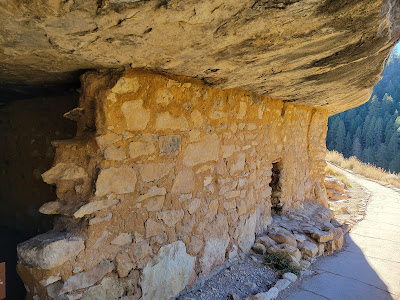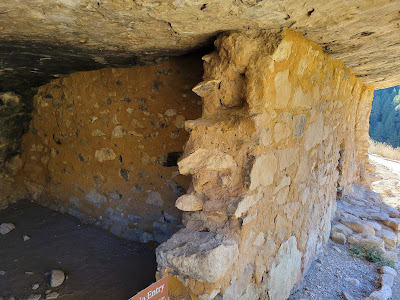Visited: Nov 2021
Nearby city: Flagstaff, AZ
High up on the Colorado Plateau, in northern Arizona, lies a network of pre-Columbian cliff dwellings, tucked deep in a narrow, winding canyon.
The ruins at Walnut Canyon were built by the Sinagua peoples. The Sinagua, a Spanish word meaning "without water", inhabited Walnut Canyon from approximately 1100-1250 AD. The Sinagua were able to live in this desert thanks to their expertise in water collection and conservation. There are over 80 cliff dwellings in Walnut Canyon, many of them accessible via the Island Trail.
The Island Trail starts at the Visitor Center (up on the rim) and descends about 185 vertical feet (via stairs) and is about 1-mile round trip. It gets you up close and personal with the ruins.
ruins along the Island Trail
The flowing waters of Walnut Creek wore down these limestone cliffs for millions and millions of years. The Sinagua took advantage of these natural recesses in the cliff walls and built their homes and communities in the alcoves. The dwellings, on average, measure two meters high by six meters long and three meters deep.
entrance sign
Walnut Canyon from the rim
stairs along the Island Trail that lead down into the canyon
if you look closely, you can see ruins on the other side of the canyon
The dwellings in Walnut Canyon were abandoned in approximately 1250 AD. The reason for the Sinagua's departure of this area is unknown, but it was likely due to a period of sustained drought or perhaps due to antagonistic neighboring tribes.
Walnut Canyon was designated as a National Monument in 1915. Enjoy your time exploring the ruins.
The other trail within the monument is the Rim Trail. This short trail (about 0.5-miles round trip) runs along the top of the rim and offers outstanding views of the canyon and there are a few ruins and pithouses up on top of the rim.
We had a beautiful blue morning sky for our visit.
the San Francisco Peaks poking above the horizon
pithouse ruins
pueblo ruins
More info: https://www.nps.gov/waca/index.htm


























































